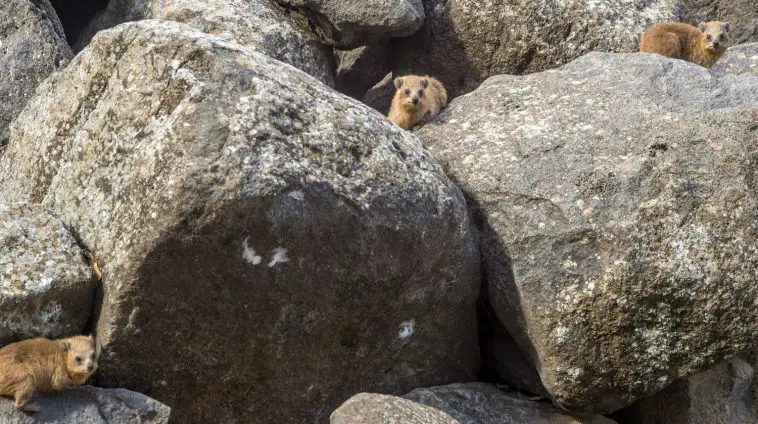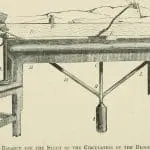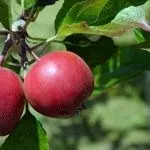The conies are but a feeble folk, yet make they their houses in the rocks. Proverbs 30:26
Growing up, I never could picture what these animals looked like. None of the English names we have for these guys meant anything to me since I’d never seen one. If you look up coney in an online dictionary, it will tell you that a coney is a fish (try to picture fish building a house in the rocks!). My kid’s dictionary says that ‘coney’ is a different way of spelling ‘cony’ which is a European rabbit.
So, now you know why I was so confused, but what are they really like?
Turns out that the biblical coney, aka rock badgers, aka the hyrax. is something that looks more like a groundhog! When I went to look them up last year, I realized that I had just read a story about their African cousins by Jan Brett. Down in Africa, they are known as Dassies, and the most common name for them in English now is hyrax [hi-raks]. The ones living in Israel are part of the Syrian rock hyrax family.
Studying this has been really fun because the first thing I saw on the African Wildlife Foundation page is that they don’t fit neatly into any group of animals. Some evolutionists say that they are close relatives of elephants, sea cows, and manatees!
Now, that is pretty crazy. God has a way of throwing wrenches into people’s neat “tree of life” machines.
From the picture, you can see that hyraxes look kind of like marmots, mongooses, and groundhogs. They have short, thick, fur that can range in color from light grey in the desert, almost orange in southern Israel, to dark brown in greener areas. They have small ears and thick bodies. Grown hyraxs weigh around 9 lbs and are about 20 inches long, so they’re a little smaller than an American groundhog.
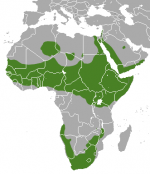
Unlike these other animals, hyraxes don’t dig deep burrows. The places they choose for homes already have piles of rocks and crevasses to live in. They keep their homes tidy by deciding on one spot to use as a bathroom so the rest stays clean.
Hyraxs love to live in groups that range from 10 to as many as 80 members. Like prairie dogs, they post a sentry (usually the dad) to keep an eye out for danger while the rest find food. If the sentry spies danger, he will call a high-pitched alarm and they all scurry into their hiding places among the rocks. This protection works so well that it is rare for one to be eaten by the south Judean wolves.
Singing is a favorite pastime for hyraxes. They seem to let each other know how they’re feeling and keep in touch with neighboring groups with all kinds of whistles, twitters, shrieks, and growls. The tree hyrax of Africa is nocturnal, so they keep the neighbors awake at night with their squeals and screams!
To stay near the protection of their dens, hyraxes only venture out about 150 ft from their homes to look for food. They’re vegetarians, eating whatever kinds of plants they can find, especially grass and leaves. They have incisor teeth that are nearly tusks (that’s part of why people think Hyraxs are so close to elephants) to chew on tough plant parts. Desert hyraxes get most of their water from the plants they eat. They can climb trees and will get into people’s gardens to munch on citrus tree leaves. They also will eat insects and grubs.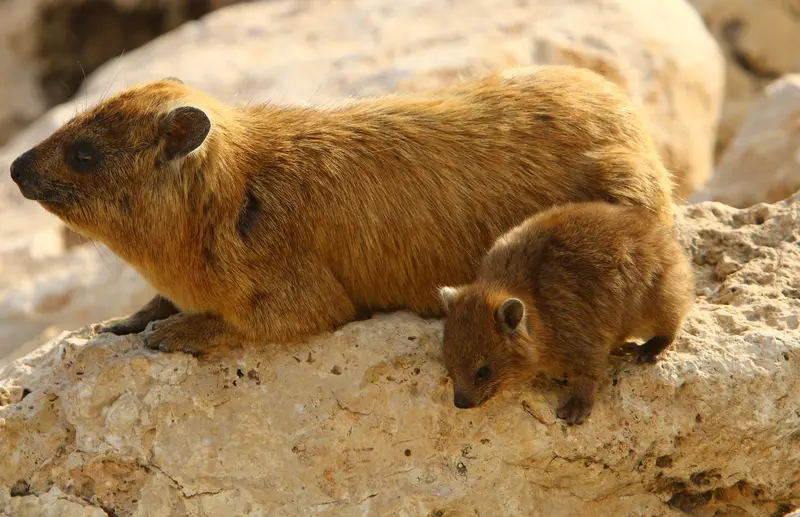
A mother hyrax is pregnant for 6–7 months before giving birth to two or three babies. Compare that to a rabbit who only takes a month to pop out 4–12 babies! Baby hyraxs are born with their eyes open and lots of fur to protect them. They start running around at just an hour old and start munching on veggies within a day or two. They take over a year to grow up, while a rabbit only takes 6–7 months, but both animals live about the same length of time — about 10–12 years.
Hyraxs are a ‘lazy’ bunch. They spend about 95% of the time lying around! During the day they spend most of the time basking in the sun. Even though hyraxes are mammals, they can’t keep their bodies constantly warm like we do. This means they get warmer and cooler with the day and night, so lying in the sun helps warm them, much like what a snake does.
Not surprisingly, the fossil record shows that before the Flood there were a lot more varieties of hyraxs. We also find their fossils in more places than they live in today, including in Europe. And (guess what!) some of them were really big, “about the size of a small horse”! Wow, that’s a big furry critter!
And God made the beast of the earth after his kind, and cattle after their kind, and every thing that creepeth upon the earth after his kind: and God saw that it was good. Genesis 1:25

